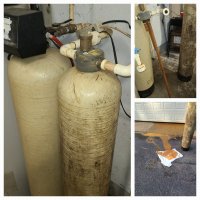I presume you mean rust red. That would be iron oxide AKA rust.
You should flush sediment out of your pressure tank periodically.
Precharged Pressure tank flush:
1. Connect a hose to the sediment drain valve, and run that to where you plan to drain the water. I suggest filtering the output through a cloth if you suspect the sediment may include sand.
2. Turn off the pump.
3. Open the drain valve, and let it drain until the water stops. It would be possibly interesting to watch the first water that comes out.
4. Close the valve, and turn the pump back on, and let pressure build.
5. Repeat steps 2, 3 and 4 as needed.
I presume you mean rust red. That would be iron oxide AKA rust.
You should flush sediment out of your pressure tank periodically.
Precharged Pressure tank flush:
1. Connect a hose to the sediment drain valve, and run that to where you plan to drain the water. I suggest filtering the output through a cloth if you suspect the sediment may include sand.
2. Turn off the pump.
3. Open the drain valve, and let it drain until the water stops. It would be possibly interesting to watch the first water that comes out.
4. Close the valve, and turn the pump back on, and let pressure build.
5. Repeat steps 2, 3 and 4 as needed.
I presume you mean rust red. That would be iron oxide AKA rust.
You should flush sediment out of your pressure tank periodically.
Precharged Pressure tank flush:
1. Connect a hose to the sediment drain valve, and run that to where you plan to drain the water. I suggest filtering the output through a cloth if you suspect the sediment may include sand.
2. Turn off the pump.
3. Open the drain valve, and let it drain until the water stops. It would be possibly interesting to watch the first water that comes out.
4. Close the valve, and turn the pump back on, and let pressure build.
5. Repeat steps 2, 3 and 4 as needed.
I presume you mean rust red. That would be iron oxide AKA rust.
You should flush sediment out of your pressure tank periodically.
Precharged Pressure tank flush:
1. Connect a hose to the sediment drain valve, and run that to where you plan to drain the water. I suggest filtering the output through a cloth if you suspect the sediment may include sand.
2. Turn off the pump.
3. Open the drain valve, and let it drain until the water stops. It would be possibly interesting to watch the first water that comes out.
4. Close the valve, and turn the pump back on, and let pressure build.
5. Repeat steps 2, 3 and 4 as needed.


